Best Jackets for Summer Outdoor Adventures
There’s no such thing as an ideal jacket – it all depends on what you’re looking for. A rain jacket? A technical softshell? Ultralight packable wind-shirt? Or maybe just a regular hard-use jacket for your daily use in the backcountry? I tried to find a good jacket (which I did actually wear) for each sub-category. Of course, it’s just my personal point of view, but hopefully, this can be a helpful guide for choosing your own best jackets for summer outdoor adventures. Before I start, I’d like to define two main jacket categories for you, which are represented here.
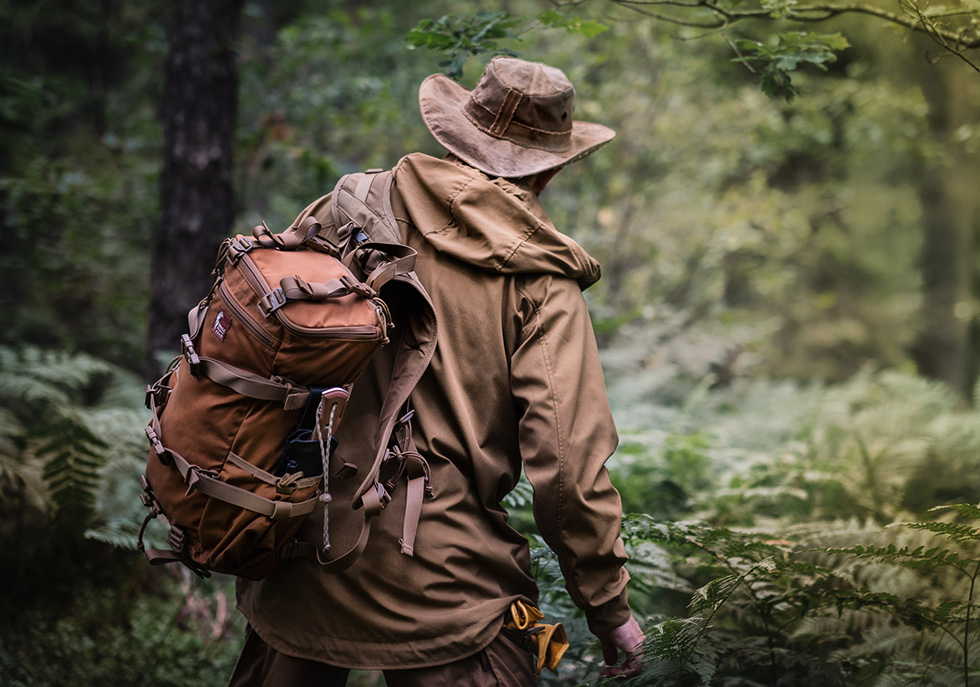
Hardshells, aka rain jackets
This one is easy – it protects you from rain and other elements in the best possible way. It’s your weather-protective armor and nothing else. With the use of a proper membrane, it also becomes breathable (to a certain extent). But also remember that the proper venting effect of a membrane requires a difference of both vapor pressure and temperature between the inside and outside of a jacket. Otherwise, it doesn’t work – it’s as simple as that. As a consequence, on a really hot summer day the effectiveness of such a membrane will be very limited. And one more hint – a trim fit is great to build that inside vapor pressure. A too-relaxed jacket won’t breathe as effectively as a snugly fitted one.
Softshells
These are really breathable jackets, which are perfectly suited for high-output activities, mountaineering, running, hiking, etc. Not waterproof but still quite water-resistant (DWR finish helps). So quite often, during a rainy summer day, you should rather wear a softshell instead of a rain jacket. Yes, you’d be slightly wet but such shells usually dry very fast and breathability is always way better than with a hardshell. And believe me, nothing is worse than sweating to death inside a non-working membrane jacket.
Now let’s delve into the best jackets for summer outdoor adventures across a range of needs and settings…
Best Ultralight Technical Softshell: Arc’teryx Gamma SL Hoody
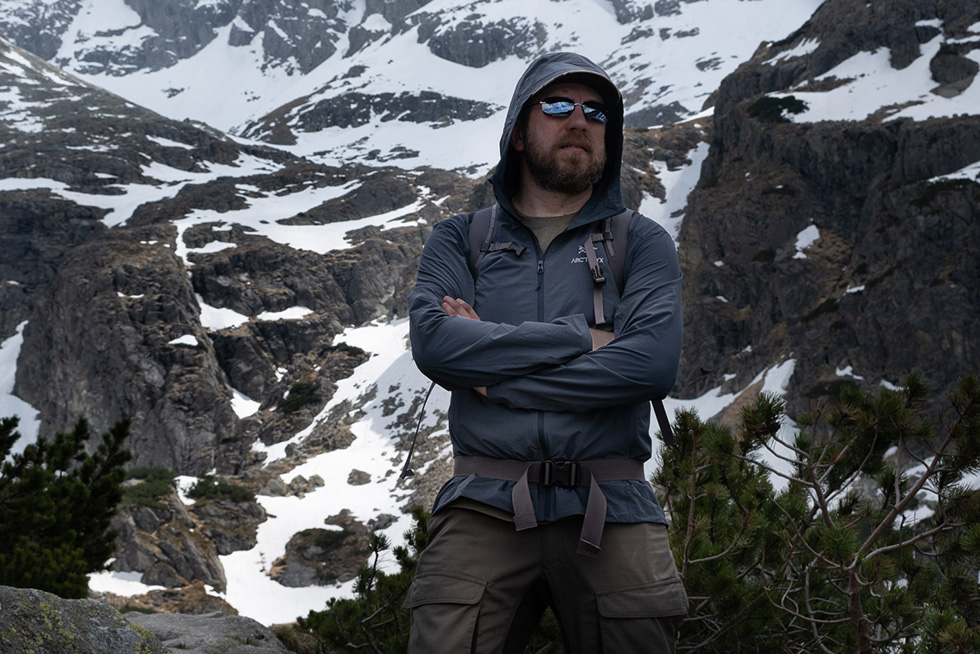
– fabric: Fortius DW 1.0 w/ elastane
– weight: 290g
– MSRP: $225
Materials and Construction
SL stands for Super Light, and indeed this is the lightest mountaineering technical softshell in both the Arc’teryx lineup and in our guide too. Fortius DW 1.0 with elastane is thin, soft, stretchy and has a great feel against the body even without an internal fleece layer (often associated with softshells). It’s also quite compact and packable. A very technical piece, designed to keep you protected from wind and light rain, while providing excellent breathability. YKK zippers with a zip-stop feature ensure easy use and long service.
Design and Features
Arc’teryx has always been known for minimalistic design, where form follows function – and the Gamma SL is no exception. The cut is quite trim, so don’t expect a lot of room for insulating/layering in cold weather. However, something like the Atom SL or other lightweight insulation can be worn under the Gamma SL – been there, done that. Since it belongs to the SL series the pockets are limited to just two on the sides. Both the hood and hem are adjustable – a must in case of really bad weather (to keep weight down the hood is only adjustable on the back). The cuffs are finished with a simple elastic band – it works and saves weight as well. The semi-rigid hood brim is a nice touch. And that’s it – don’t expect too many features in the SL series.
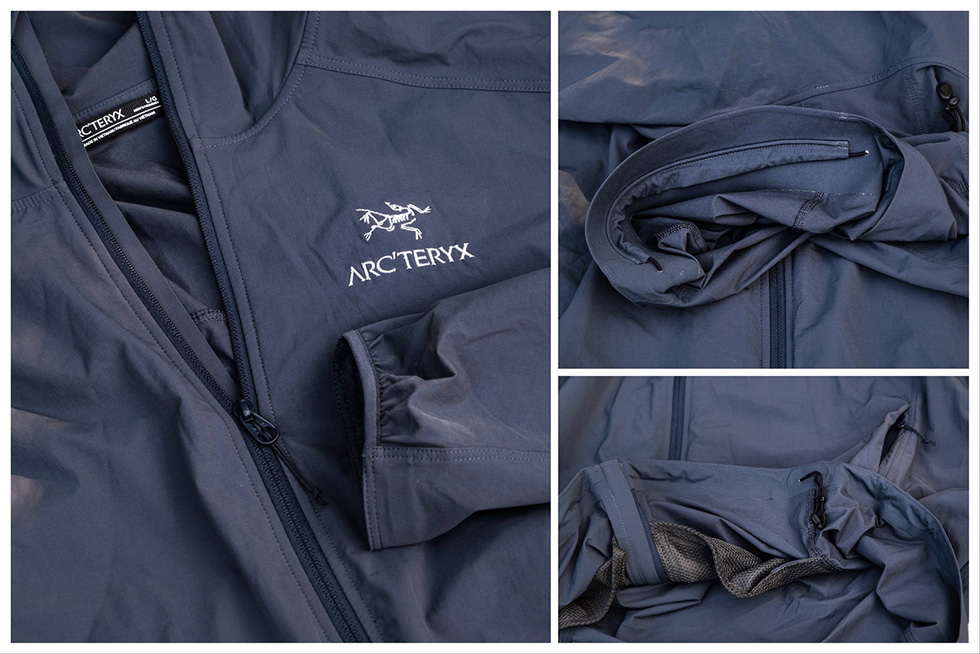
Reality
This piece has a firm place in my backpack when I’m mountaineering in the warm season. It won’t eat up a lot of space inside a backpack; I can fit it in a super-small drybag (well below 1L in capacity). It’s a shell I usually use between June and September, depending on actual weather conditions. If you’re into really high-output activities, like ski-touring, this jacket can also be a fantastic solution during sunny winter days. The breathability of the Gamma SL is nothing short of impressive, especially considering that I still use it as rain protection in light and short summer rain. Of course, it’s not a dedicated rain jacket, keep that in mind. It dries super-fast too.
However, it’s not as tough and abrasion-resistant as other pieces in this article, so keep that in mind. I’d not bring it to any kind of bushcraft/forest application; even regular hiking in bushy terrain is not the best application for the Gamma SL.
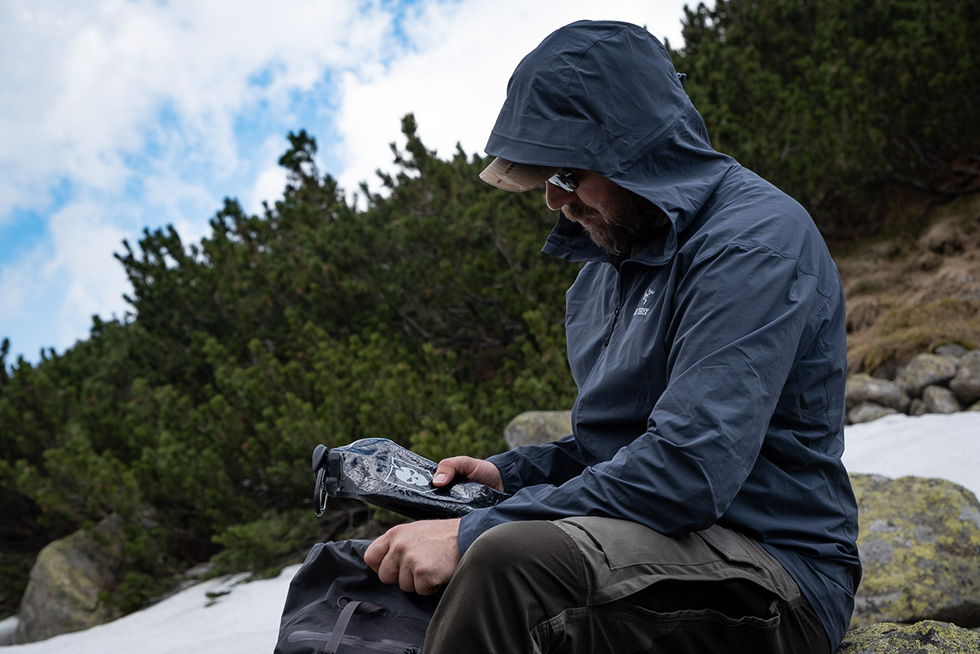
Strengths:
– super lightweight and packable
– great breathability
– very good protection against wind and even light rain
– dries fast
Best Overall Softshell for Alpine Sports: Arc’teryx Gamma LT Hoody
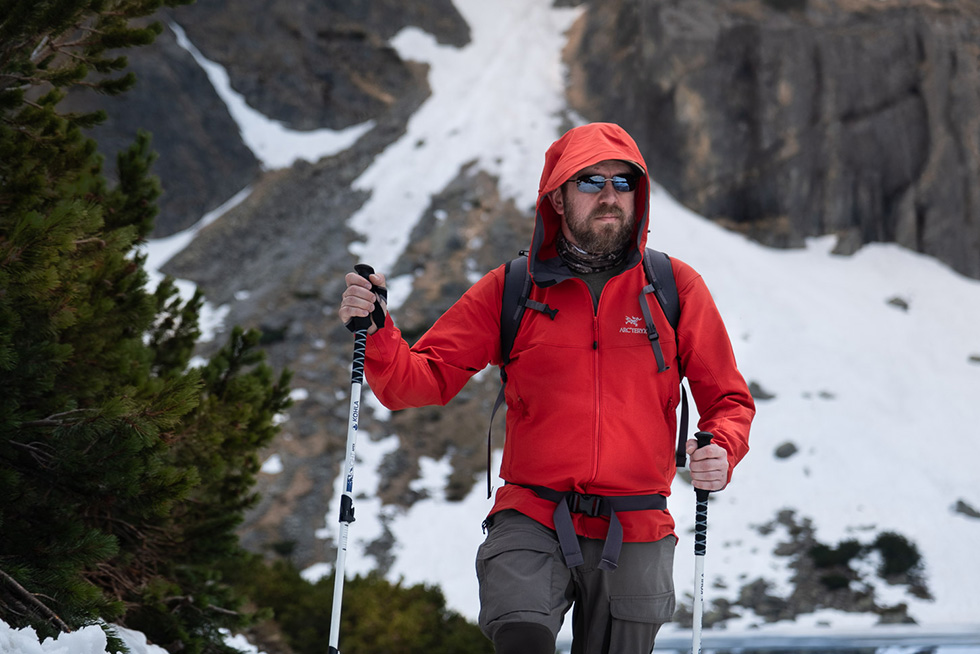
– fabric: Wee Burly Double Weave w/ elastane
– weight: 545g
– MSRP: $249
Materials and Construction
LT means it’s a lightweight piece, but with durability and features being just as important as weight. So while not the lightest in its category, it’s regarded as one of the most versatile and one of the best softshells ever made. Wee Burly Double Weave is not only stretchy, soft, and breathable, but extremely durable too. That’s the same material the legendary Arc’teryx DRAC in the LEAF military line was made of. You can take it anywhere and it’ll take care of you. It’s a regular-fit piece, so you can wear light or medium insulation under it, like the Atom SL or Proton FL. The sleeves are pre-angled, which helps in sports like mountaineering, scrambling, and even climbing. YKK zippers, of course.
Design and Features
This one, contrary to the SL version, is quite feature-rich. It has two generous side pockets plus one laminated internal zipper pocket for keys or small valuables. There’s a fully adjustable hood (front and back) with a rigid brim for that extra rain protection. The cuffs are elastic too – not adjustable, but it’s a more complex construction than in the SL, which works really well and keeps the cuffs quite tight around the wrists for added protection from the elements. This is, without any doubt, one of the best-looking mountaineering softshells out there.
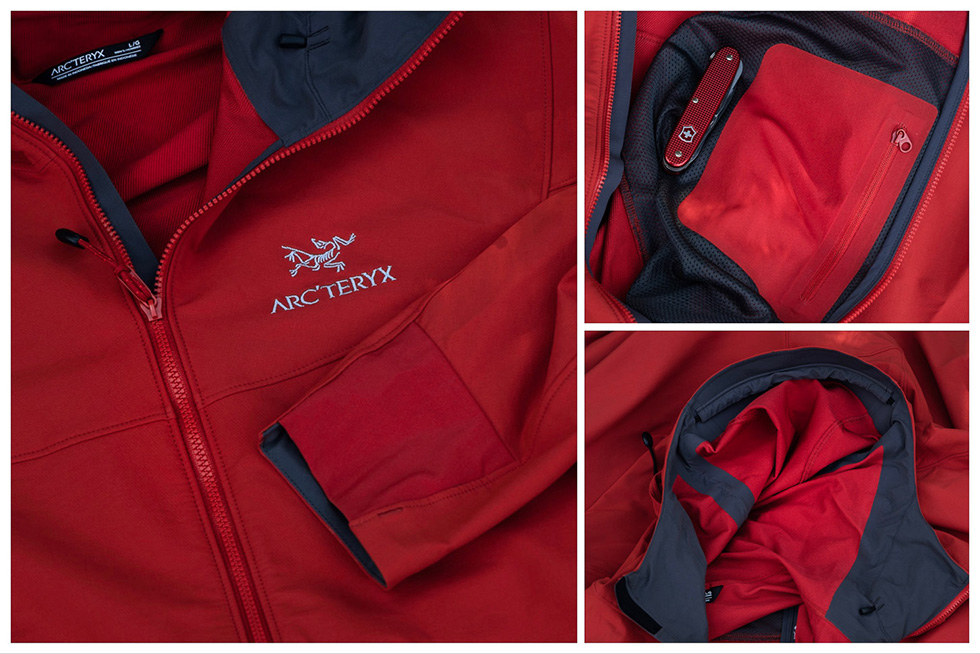
Reality
It’s essentially a year-round use hoody, which offers really serious protection from the elements and has slight insulation properties to it. Not much, it’s not fleece-lined like the Gamma MX… but that makes it one of the most versatile softshells on the market. It’s not a pure summer piece, but I often use it in June and September in the High Tatras mountains, when there’s still quite a lot of snow above the tree line and temperature can easily drop down to just 5-10°C. So yes, it can be a perfect softshell for early summer in alpine mountains.
It’s one of the toughest shells in my collection too, it’s very resistant against rock and ice. I’ve been using one for a couple of years, in all seasons and some really bad weather conditions. It can easily shed medium rain and snow on the trail, and given the robustness, the breathability of the Gamma LT is very, very good. I used to have one in light gray but switched to the new classic red. It’s a truly iconic piece and one of the best-selling Arc’teryx pieces. And there is a reason for that.
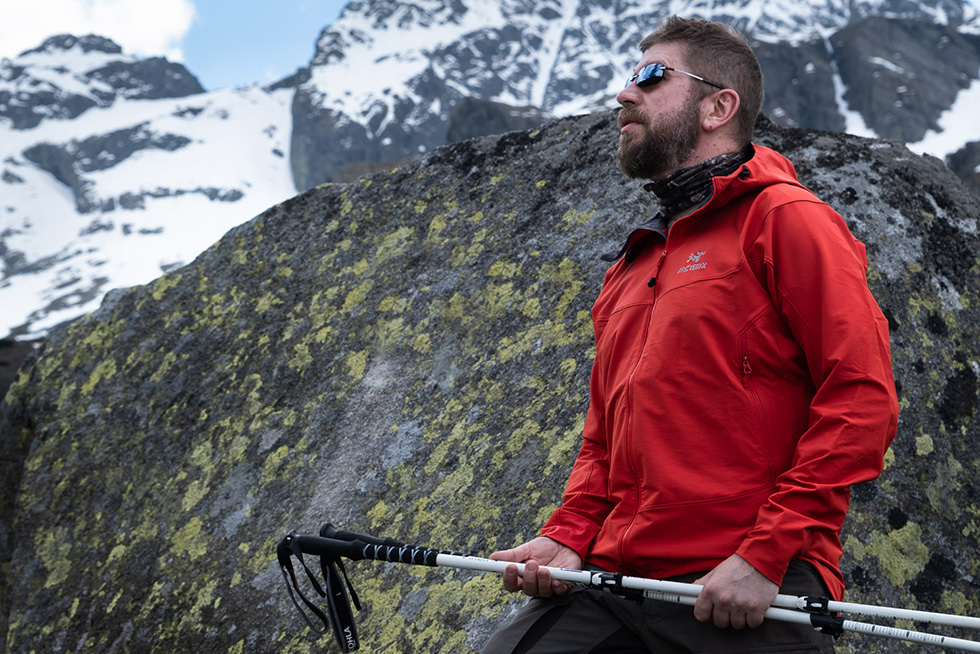
Strengths:
– versatility of a 4-season shell
– rugged material
– very good protection in heavy conditions
– regular fit for use with insulating layer underneath
Best Ultralight Summer Insulation: Arc’teryx Atom SL
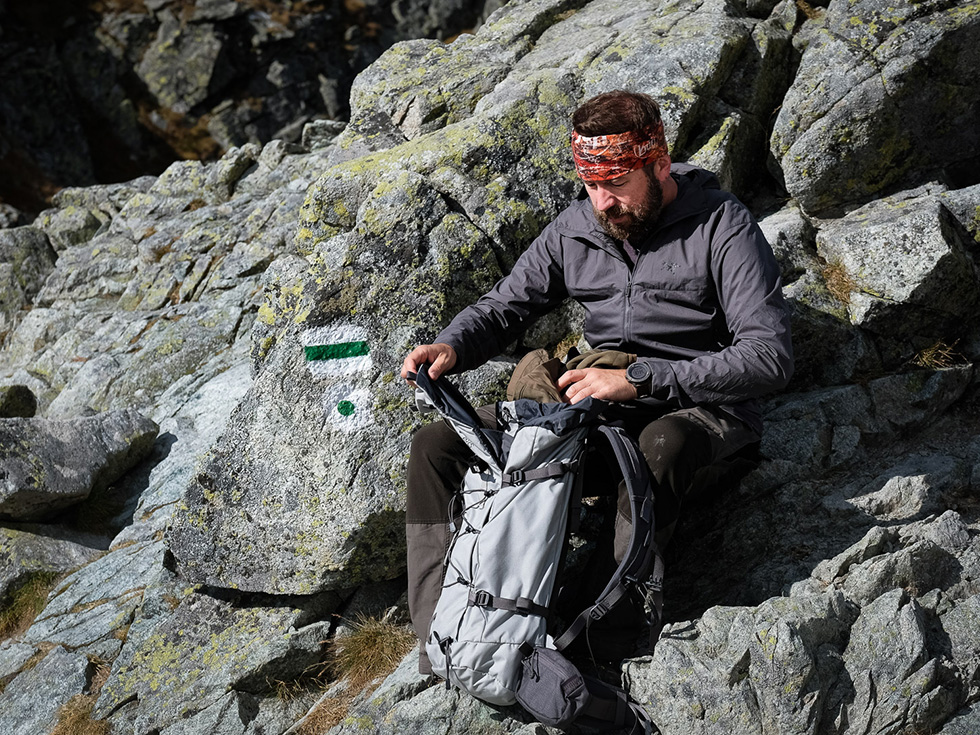
– fabric: Tyono 20, Coreloft Compact 40 insulation
– weight: 270g
– MSRP: $229
Materials and Construction
The Atom line has been created as the most versatile insulation in Arc’teryx. And the Superlight version is proof that insulation in summer has its place as well. It’s essentially a combination of a wind-shirt, hoody, and superlight insulating vest. It’s filled with superlight Coreloft on the front and back of the torso, while the sleeves are made of thin softshell with a tricot liner. The hood is there only for wind protection. And for extra breathability, the sides of the torso and underside of the sleeves are made of thin stretchy material. You’ll find YKK zippers and a trim fit, perfect for use under a thin softshell or hardshell. The overall design is like a crossover between the Gamma SL and Atom SL vest, but without doubling the layers. It’s available in multiple color schemes.
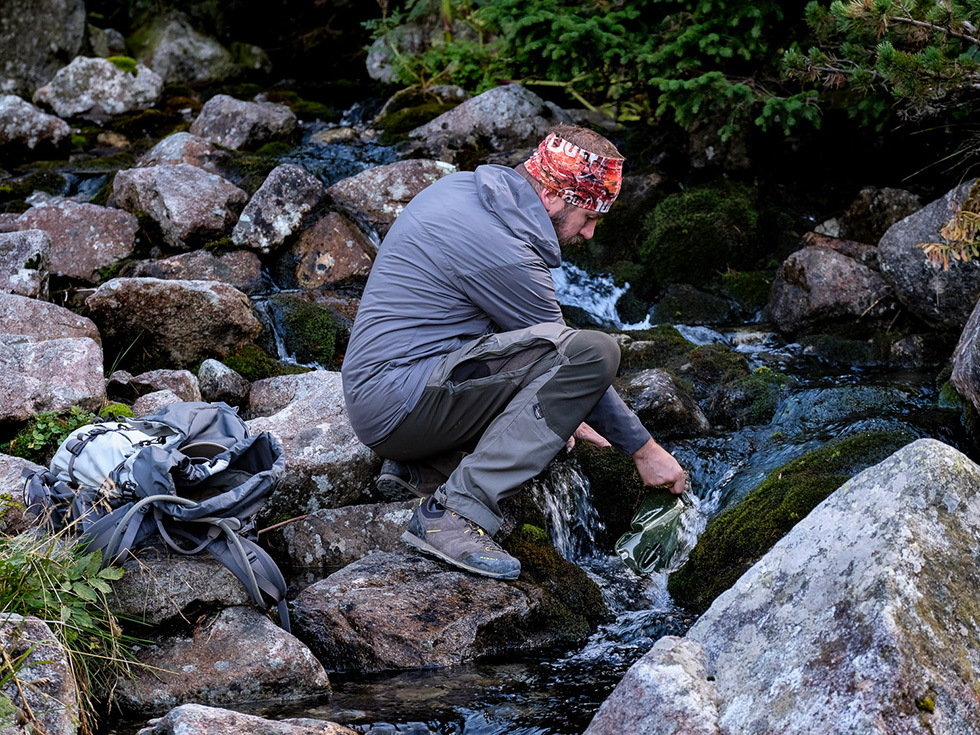
Design and Features
This is one of the most complicated pieces to make – Arc’teryx combined four different kinds of materials and many features into a slick-looking piece, which weighs a mere 270g. Two handwarmer pockets only, usual for the SL line. A fully adjustable hem with a slightly longer back part. An adjustable hood with a brim stiffener hidden inside. It’s extremely packable for an insulating layer. I can stuff it into a 1L drybag, which (after rolling it down) becomes smaller than my 400ml small Nalgene bottle.
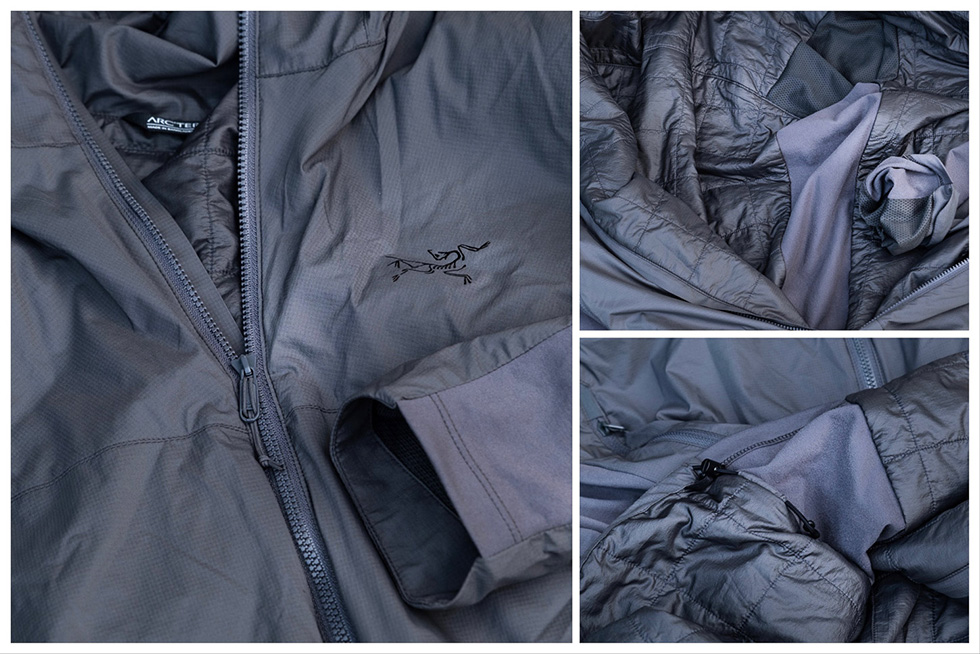
Reality
I had some reservations when I tried it for the first time. Now, after a full year of using it, I can’t imagine my mountaineering life without it. It’s the only insulation that I use for summer hiking, and it never lets me down. It insulates, it breathes, it dries super-fast, and Coreloft works even when wet. It’s super-light and takes up very little space in my pack. When paired with a softshell and a hardshell, it makes an unbeatable summer clothing combo, which is fine for anything. The Atom SL is also a great insulating layer for mountain bikers on chilly mornings in May or September/October. Any downsides? Well, being so light it can’t be very durable too, so keep that in mind. It’s not an outer piece for an adventure in the Scandinavian forest. I use mine mostly above the tree line, that’s where it really shines.
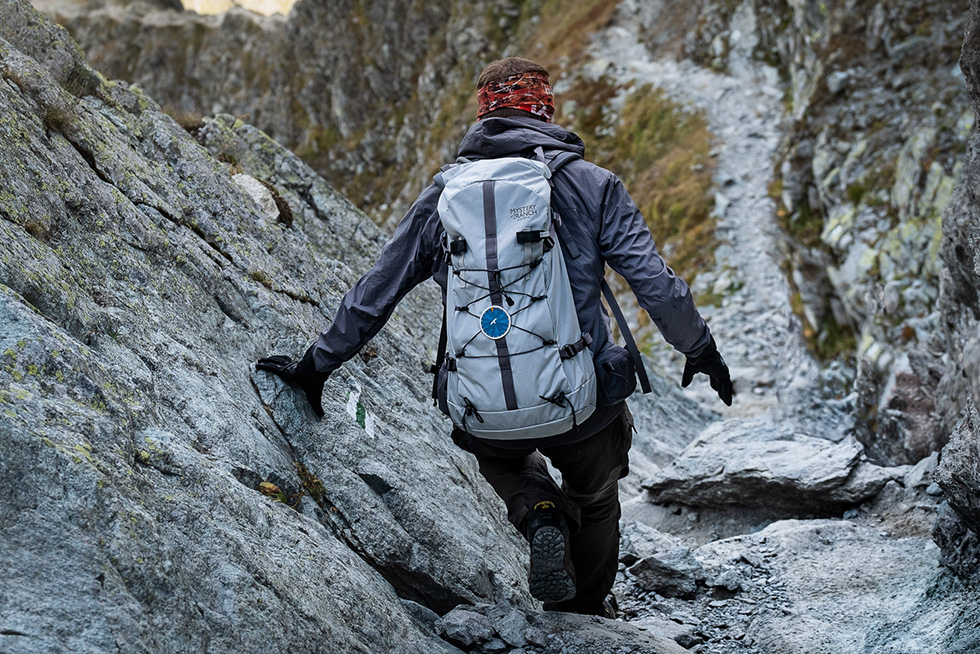
Strengths:
– ultralight and compact
– combines multiple materials for extremely good thermal performance and comfort
– good fit
– versatility for use as a standalone piece or combined with a shell
Best Overall Rain Jacket: Arc’teryx Beta LT
– fabric: N40d 3L GORE-TEX w/ tricot backer
– weight: 395g
– MSRP: $399
Materials and Construction
For many people, Gore-Tex technology is a synonym for a waterproof breathable jacket. Well, it’s not as easy as this, but there’s a grain of truth in that thinking. The Beta LT is versatile, lightweight, and rugged enough for regular use, not just as an emergency shell. The Gore-Tex membrane with soft lining, laminated together with 40D fabric makes it a classic 3-layer jacket. The membrane as such is positioned performance-wise between Gore-Tex Pro and PacLite. Another benefit of that material is the cost of the jacket. At $399 (MSRP, so you can probably find it even cheaper) it’s a really fair-priced 3-layer piece from Arc’teryx. A trim fit, technical styling, waterproof YKK zippers, thin 1.6mm seam tape, full lamination… it’s a really good mix of design and technology.
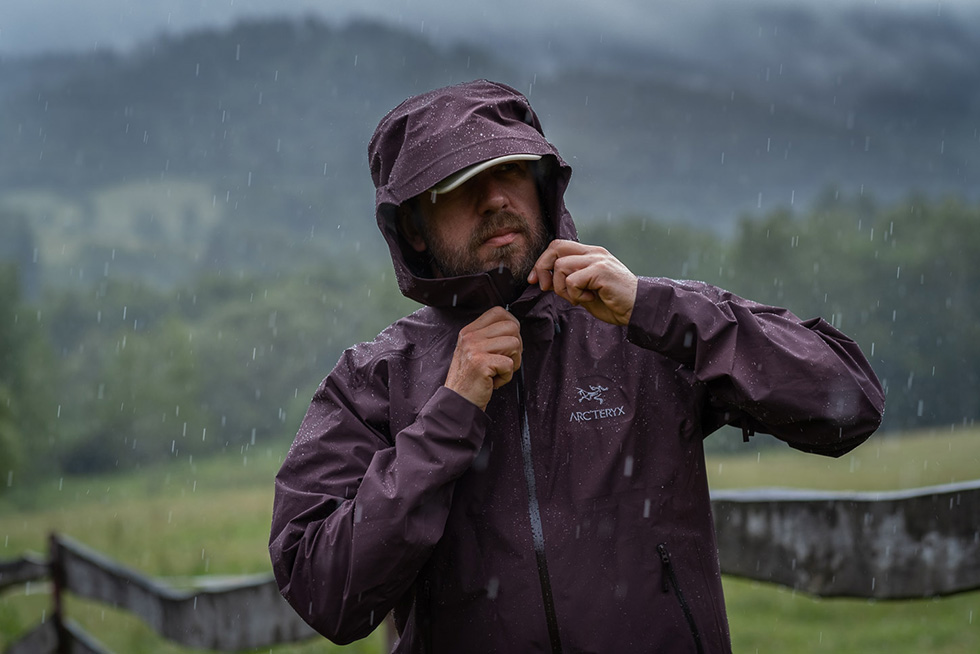
Design and Features
Well, what’s the big deal? You’ve been using the Beta LT for years, right? Wrong! This is a completely new Beta LT. It’s not a refreshment, it’s a new jacket with new features. The new tricot backer technology feels a bit like the C-KNIT™ backer (from the Zeta LT, discontinued) but it’s thinner, so it transfers sweat even better to the membrane.
There are two side pockets only – could have an additional internal one but you can’t have everything, right? A fully adjustable hem with two locks on the sides (they also prevent slipping from under a harness). A fully adjustable hood with rigid brim. Hypalon and Velcro cuff adjustment straps. And full lamination of each and every seam with thin and light sealing tape. And yes, finally most welcome pit-zips with watertight YKK low-profile soft zippers! As I said – it’s a new jacket and Arc’teryx used their finest technology to make it. Don’t quote me, but at even below $399 (street price) this might become the most popular Arc’teryx hardshell ever.
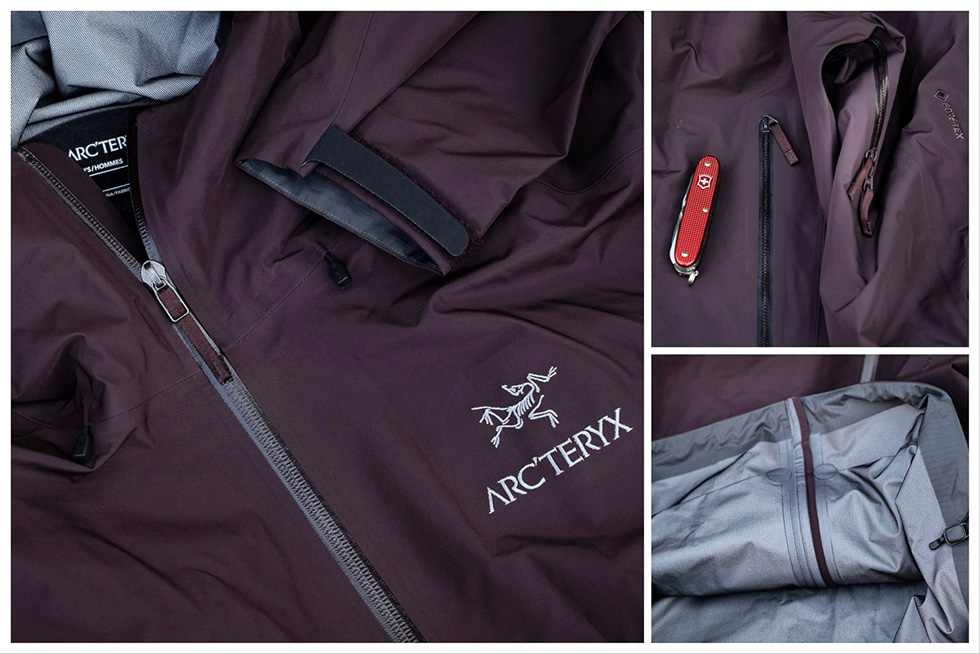
Reality
I’ve never used the Beta LT before, so I can’t directly compare it to the old model. But I’ve been using the Alpha SV, Alpha FL, LEAF Alpha LT, and Zeta LT in my hiker’s life so after two months of use I can tell if a shell is good (or not). First of all, the ‘next to skin’ feel of the tricot backing is just so nice! For summer use, when you wear a jacket often just with a t-shirt, it’s more important than you may think. It breathes well, especially on colder days, so in heavy rain and stormy weather. In light summer rain during a hot day a hardshell would be my last choice actually.
But anyway, the Beta LT is fully waterproof even under the heaviest rain, so sometimes, especially at a higher altitude, it’s an essential piece. I tried it between 1000m and 2000m above sea level in June and July, in anything between 12 and 20°C, and it did a good job. The trim fit helps too – a hardshell works much better if it’s close to the body. The fabric is a bit stiff and ‘crunchy’ when moving in the jacket, so if you’re stalking birds or other wildlife with a camera, this is probably not your perfect garment. But for everything else, it’s a really good shell, which becomes exceptionally good in spring and autumn, when the weather gets colder.
Strengths:
– fully watertight
– new features incl. pit-zips
– tricot backing technology
– a lot of Arc’teryx top technology for the price
Best Heavy-Duty Summer Rain Jacket (Stealthy): 66°North Snæfell
– fabric: Nylon 4-way stretch w/ Polartec Neoshell membrane
– weight: 510g
– MSRP: $525
Materials and Construction
This is not your standard rain jacket. This is like a work of outdoor art, designed in Iceland and perfectly executed in Lithuania in the European Union. 66°North used a Polartec Neoshell membrane in a 3-Layer laminate, which is slightly different from Gore products. It’s made with high output activities in mind, so it vents the sweat easier than classic Gore-Tex, but in extreme conditions, the waterproofness is somewhat behind Gore products. However, for a summer rain jacket, that might be a good trade-off. The material is very soft and silent in use, also the outside layer is non-reflective in appearance, which could be a good thing in some outdoor applications. It’s a regular-fit jacket, with enough space for some insulation. A slightly longer back protects the lumbar area from wind. It’s equipped with a YKK AquaGuard two-way zipper.
Design and Features
Iceland is not a place associated with hot summer vacations. So if it’s designed with Iceland in mind, it must be good at protecting against the elements and also durable for daily use. The outer material is tough and strong, all seams are fully taped. It features two big side pockets but also a small pocket on the left forearm (good for an RFID pass card, but not only). Inside you’ll find a dedicated quick-access pocket for a mobile phone and a small zipper pocket for valuables. It has an adjustable hem, adjustable hood (front and back), and a rugged brim with elastic band for extra protection. It also features fully adjustable cuffs with Velcro tabs and an enlarged front zipper pull, which is also easy to grab when wearing gloves.
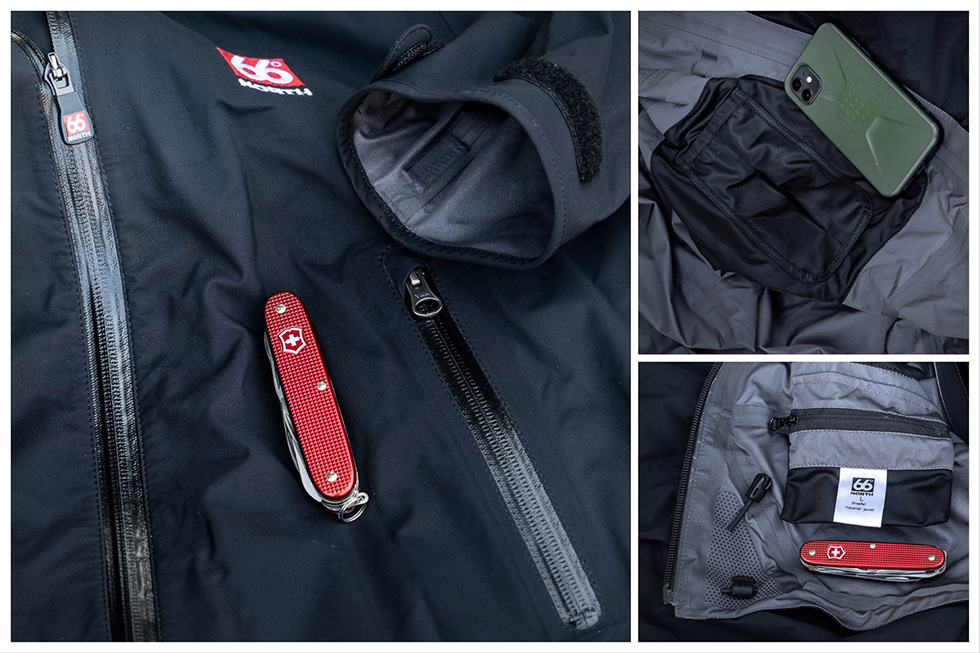
Reality
The Snæfell jacket is packed with extra features, durable, and is really stealthy (which comes into play if birdwatching is your game). I tried it in the Tatra Mountains in June and to me, it’s a classic spring and summer rain jacket. For autumn and winter, I’d use a dedicated cold-weather membrane, which is the ideal approach – dedicated seasonal shells for warm and cold seasons. It breathes exceptionally well (for a hardshell) even without a big temperature difference in/out. The only downside is the weight – at above 500g it is on the slightly heavy side for a summer shell. However, if your summer adventure takes you to Iceland rather than to SoCal… that additional 150g is not really an issue. A rugged garment must have some weight to it, there’s no other way.
Strengths:
– tough and rugged
– very good breathability
– stealthy look and feel
– multiple pockets incl. two inside
Best General-Use Casual Hooded Jacket: Fjӓllrӓven Sten
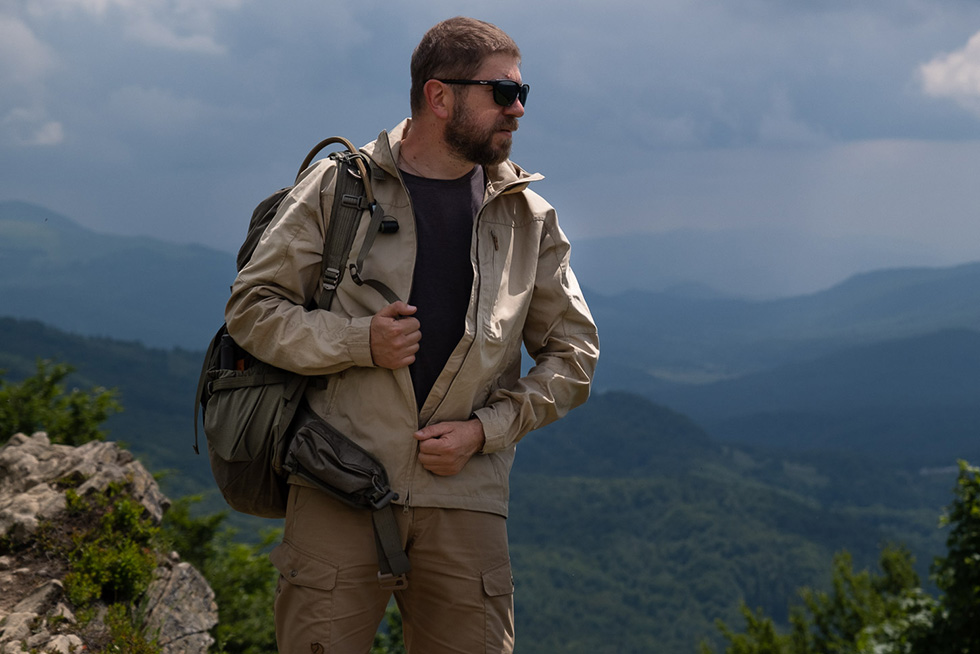
– fabric: G-1000 Lite
– weight: 430g
– MSRP: $200
Materials and Construction
G-1000 Lite is a warm climate-oriented version of G-1000, a fabric Fjӓllrӓven is famous for. It actually made Fjӓllrӓven the brand it is now. G-1000 Lite is a lightweight blend of polyester and cotton, but with a ripstop structure for toughness and it’s also slightly waxed, which adds DWR properties to it. And just as with the original G-1000 it can be waxed even more for full protection in critical areas if desired, at the hem, hood, and elbows. It’s a classic jacket, not a modern technical marvel. It has a regular fit and is long enough to protect the bottom torso parts from wind and chill.
Design and Features
The Sten jacket, due to both material and overall classic design, has kind of a vintage feeling to it, which is very satisfying in daily backcountry use. There are two side pockets, a spacious Napoleon chest pocket, and two drop-pockets inside for work gloves, a puukko, buff, etc. Plus an adjustable hem and sleeves, YKK zippers with leather trims, and a very comfy hood with chin protection. I really like this classic design, it’s not overloaded but still features five big pockets. The waxed canvas has a bit of a wrinkly look, which is one of the most iconic features in classic Fjӓllrӓven gear. It looks “Arctic explorer good”.
Reality
The Sten is a mid-weight piece optimized for Scandinavian summer: humid, cloudy, about 20°C average daily temperature and dropping down to 12-15°C at night. This jacket is breathable and can shed some light rain too. It dries very fast and looks great in daily summer use – at a ranch, in the backcountry, even in a city. I’ve been using it quite often as a general-use jacket around camp, at a mountain ranch when working with horses (great protection from fly bites too), and sometimes in the forest-covered wild Bieszczady Mountains on the border between Poland and Ukraine. I know I’ll use it a lot in the city too. It’s a very versatile jacket.
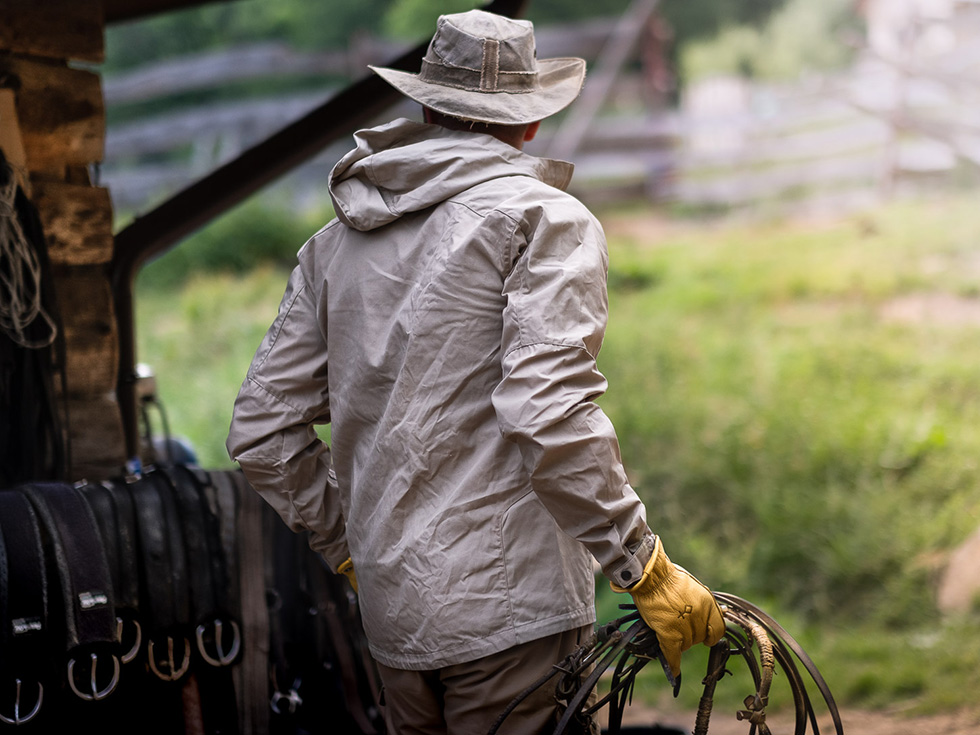
Strengths:
– versatility
– tough fabric, slightly waxed for DWR properties
– classic look and feel
– 5 big pockets can carry a lot of gear
Best Superlight Wind and Sun Jacket: Fjӓllrӓven Abisko Midsummer
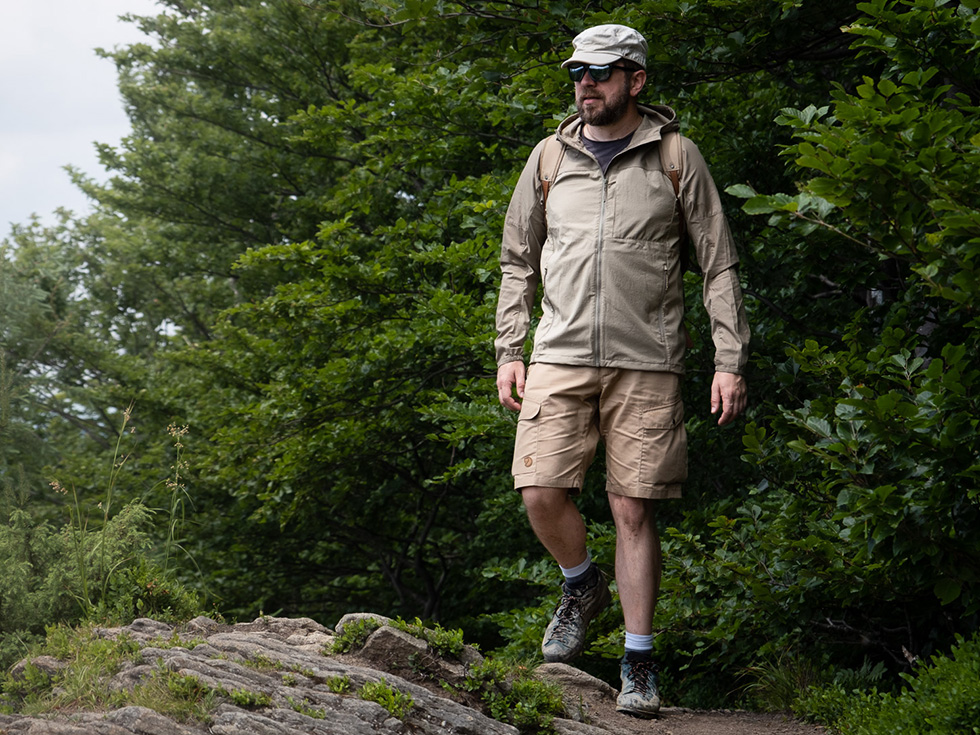
– fabric: G-1000® Air Stretch
– weight: 360g
– MSRP: $200
Materials and Construction
This jacket is made mainly of G-1000 Air Stretch, which is another variant of Fjӓllrӓven’s legendary poly-cotton fabric. It’s designed for best breathability and protection from not only wind but also sun. It’s the lightest variant of G-1000, which can still be waxed if required, and which is still tough for daily hiking due to the ripstop structure. This jacket is one of the lightest (if not THE lightest) in Fjӓllrӓven’s collection dedicated to regular outdoor activities. The low back and sides are made of an even thinner non-ripstop 4-way stretch variant for unrestricted movement. Internal parts of the pockets are made of mesh, so it’s breathing equally well on the whole surface. It’s compact and packs really small, more or less to the size of a Grayl Ultralight filtering bottle, which is roughly 400ml in volume.
Design and Features
The Abisko Midsummer’s fit falls between trim and regular. It’s superlight, supersoft, with lightweight YKK zippers and thin cord pulls. The top back and shoulders use material with a rip-stop structure, so it’s strong enough for backpacking, day hiking, and all other summer activities that require bag/pack carry. It has two side pockets, one Napoleon chest pocket, an adjustable hem and hood, plus elastic cuffs. All you need in a lightweight outdoor jacket.
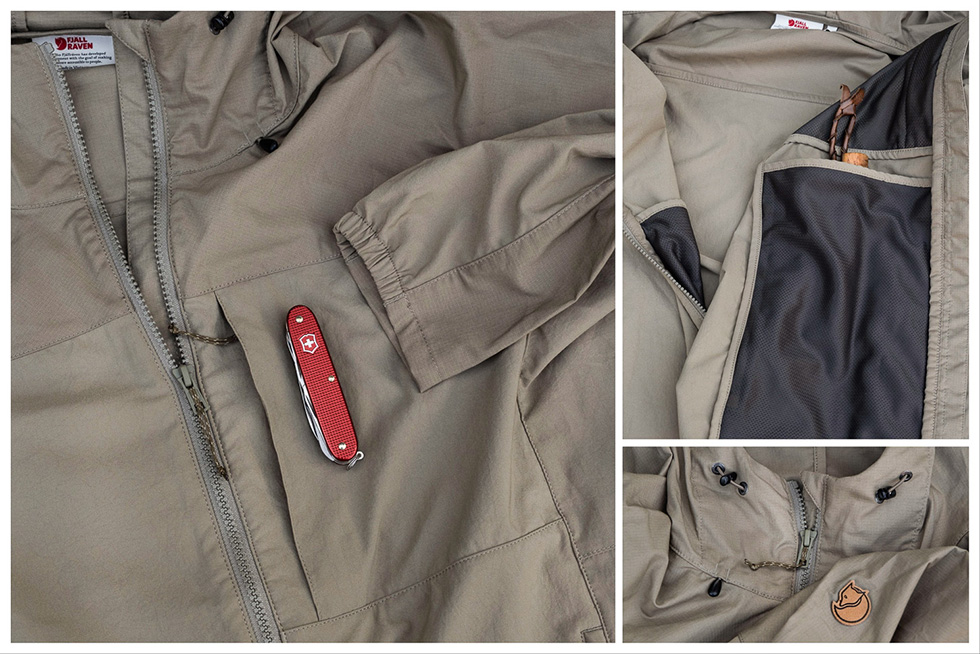
Reality
This one shines on sunny and windy days, when you wear just an active t-shirt and need some sort of wind protection on top. It stops most of the wind, but allows some air to go through the fabric, so you still get a nice refreshing breeze when wearing this jacket. And it rocks in the summer season. Hot mid-summer season mountaineering at/below tree lines is a great application for this jacket. And so is summer sailing, when you need protection not just from sun and wind, but also light sea spray and even occasional spindrift. In such sunny-windy conditions it dries almost instantly.
It’s a nice leisure jacket too – it should be a perfect companion for beach walking in the afternoon. It’s a really versatile piece for sunny and windy conditions when just a t-shirt is not enough, but a softshell would be overkill. It doesn’t look too technical, which makes it a good everyday lifestyle jacket as well.
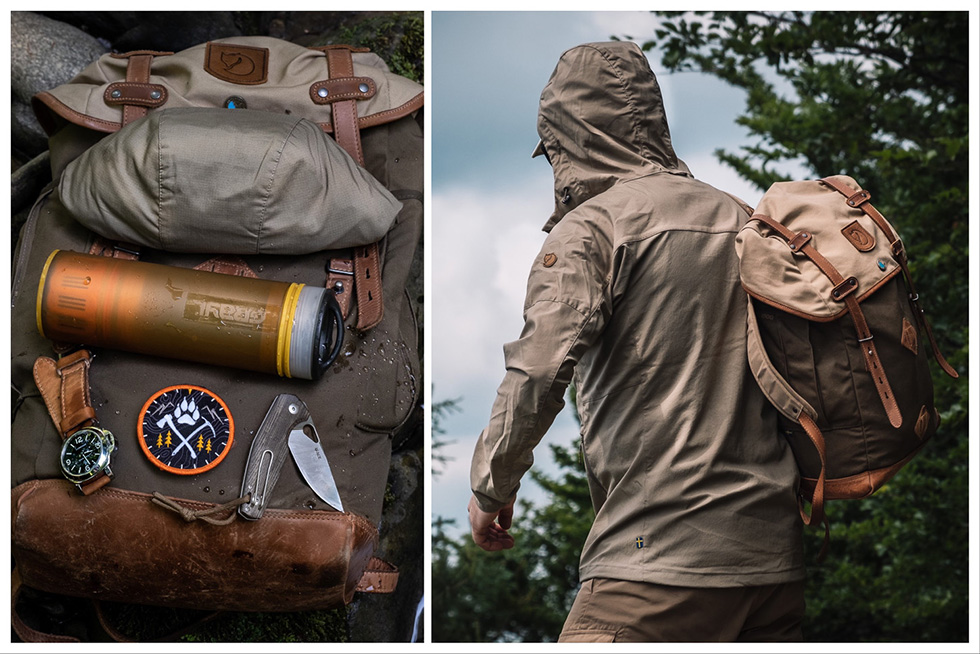
Strengths:
– ultralight but tough G-1000 Air Stretch fabric
– protection from sun and wind
– perfect beach/sailing jacket
– classic non-technical look that’s good both for backcountry and urban use
Best Overall Lifestyle Shirt-Jacket: ThruDark SF Hybrid Jacket
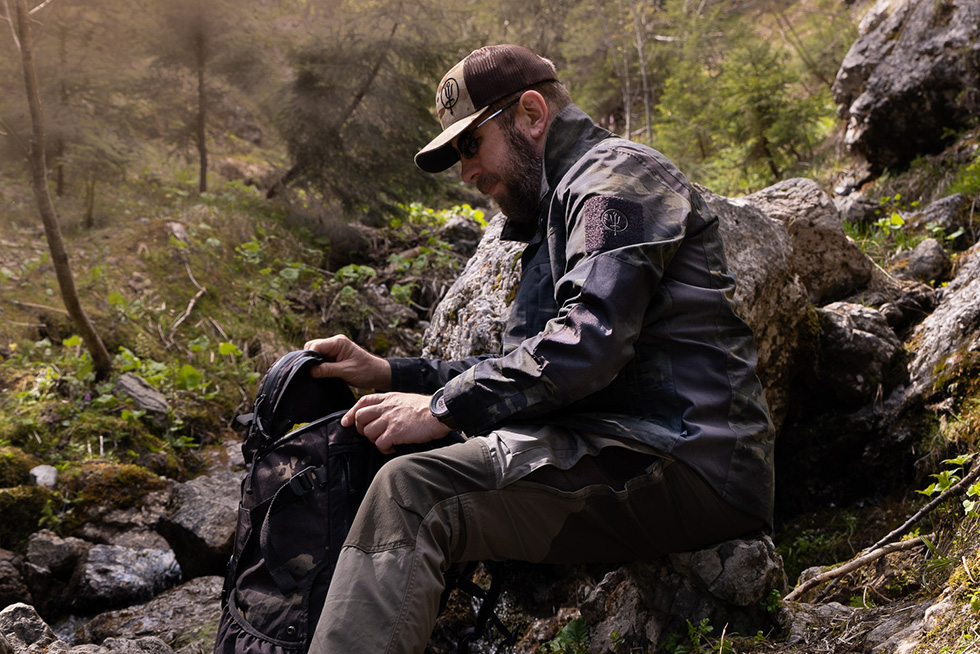
– fabric: DWR NYCO RipStop + 4-way stretch
– weight: 495g
– MSRP: $450
Materials and Construction
I’m not easily surprised by outdoor gear but this is like nothing I’ve tried before. It’s a cross-over between a classic shirt-jacket, softshell, and soldier’s uniform – hence the name. It’s designed by Special Forces veterans in the UK, and made in Italy. The material is (mostly) a classic NYCO RipStop (nylon-cotton blend), which has been proven for years in the military world to be strong, fast-drying, and with adequate ventilation properties. It’s not the lightest piece, but really tough. It’s also not too soft and stretchy, however ThruDark found a solution with 4-way stretch panels on the sides for a perfect fit to the body, unrestricted movement, and enhanced breathability. Tough YKK zippers, metal snaps, aramid thread reinforced elbows… this thing is a tank of a shirt-jacket.
Design and Features
A classic look with a modern military twist is the best description of ThruDark’s design philosophy implemented in the SF Hybrid jacket. It’s packed with features: two side handwarmer pockets, two chest Napoleon pockets (big enough for a passport, mobile phone, wallet), and two spacious drop-pockets inside for gloves, buff, etc. Each sleeve has a big Velcro panel for morale patches (with bold TD logo), elbow reinforcement with a soft protective insert (removable), and an adjustable cuff with two metal snaps. The collar can be used both in a flat and stand-up position (with a special strap). The fit is quite athletic, but with “soldier silhouette” in mind so it’s not a skinny-trim type. It looks really good, and the mix of black accents and MultiCam Black body gives it a tough military appearance, even slightly intimidating I’d say.
Reality
If it’s tough enough for soldiers, it’s tough enough for an ordinary outdoorsman too. I don’t think I’d be able to harm this jacket under even the harshest conditions. But being so overbuilt and black it is dedicated for use during the cloudy days, not under direct sun. I had it with me in the mountains, and it did a fine job during a chilly morning walk. But it’s not a technical piece, neither ultralight nor packable. But for low-output activities, walking in a forest, outdoor photography, overlanding, casual archery, and many ranch-life activities, etc. it’s a really good alternative to a standard shirt-jacket.
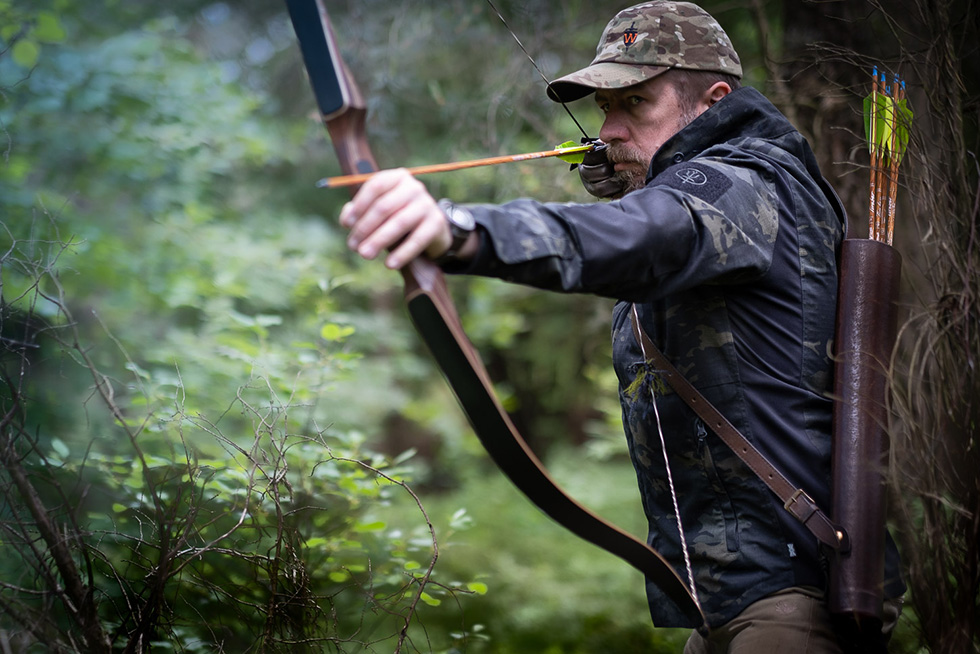
It’ll last forever and I’m sure it’ll look better and better with time. It’s one of those pieces that should age really well. Also tough NYCO fabric like this requires some break-in period, but after the first season it should be a perfect workhorse companion. If I may ask ThruDark for one thing… please make one in coyote too, it should then be perfect also for more sunny days. Last but not least, it would make a really cool and bold lifestyle urban piece too. But be warned – this jacket is sure to turn heads.
Strengths:
– extreme toughness, strong materials
– 6 big pockets
– 4-way stretch sides
– MultiCam Black and overall cool look
Best Overall Backcountry Jacket: Hill People Gear Wind Cheater
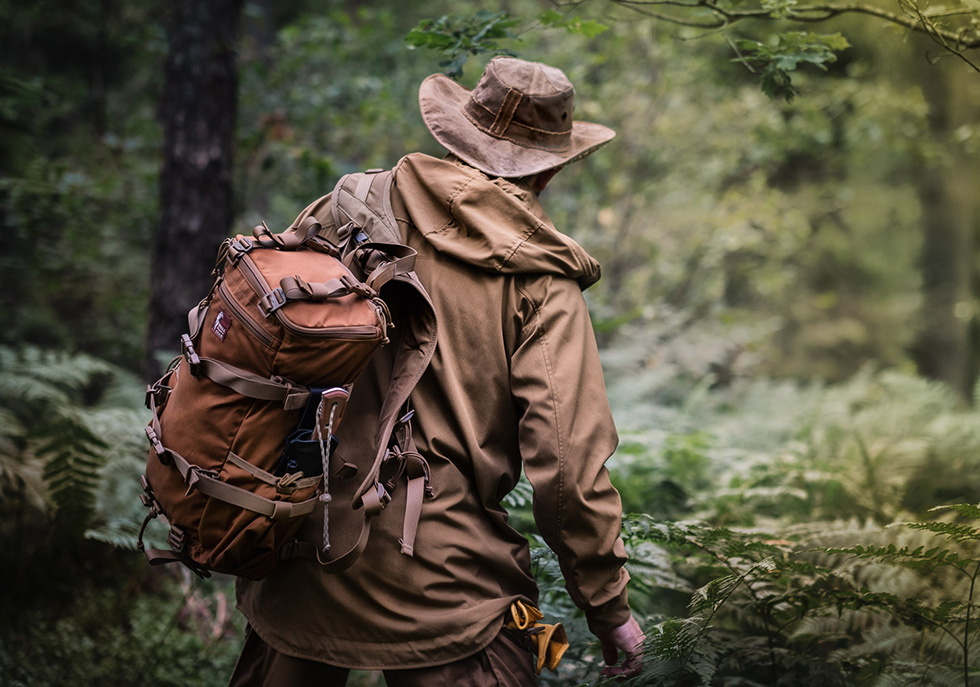
– fabric: Cordura Ambush (stretchy)
– weight: 650g
– MSRP: $235
Materials and Construction
It’s tough as nails, but also soft, slightly stretchy, and totally silent under movement – that’s Cordura Ambush. It’s also super breathable and thanks to a DWR treatment it can shed light summer rain. The overall construction is very durable too, with stitch-fold-stitch double stitching and multiple locking stitching reinforcements in critical spots. It has Hypalon sleeve adjusters, tough zippers, and military-grade shock-cord and hardware. And it’s fully produced within the USA, in the First Spear facility in Missouri. There’s no weak link in this chain – both materials and construction are ready for any outdoor conditions.
Design and Features
The HPG Wind Cheater is an outdoor variant of a military jacket offered directly by First Spear. It’s been re-designed by Scot and Evan Hill to make it more hiking-oriented, so these two jackets are close brothers, but not twins. It’s a relaxed-fit jacket, so depending on conditions you can still use a mid-layer under the Wind Cheater. The generous hood is fully adjustable, can easily be worn over a helmet if necessary, and can even be fitted with an optional coyote fur ruff for cold season use (it’s a 4-season jacket).
Other features include a longer back for wind protection when wearing a backpack, adjustable sleeves and hem, bungee cord maintenance loops, a wind protector behind the main zipper, and also pit-zips for added ventilation. And pockets, of course, two handwarmer pockets and two zipper Napoleon pockets – all of them high in the chest area, so they can be easily reached when carrying a heavy expedition backpack. Clearly an outdoor-oriented set of features.
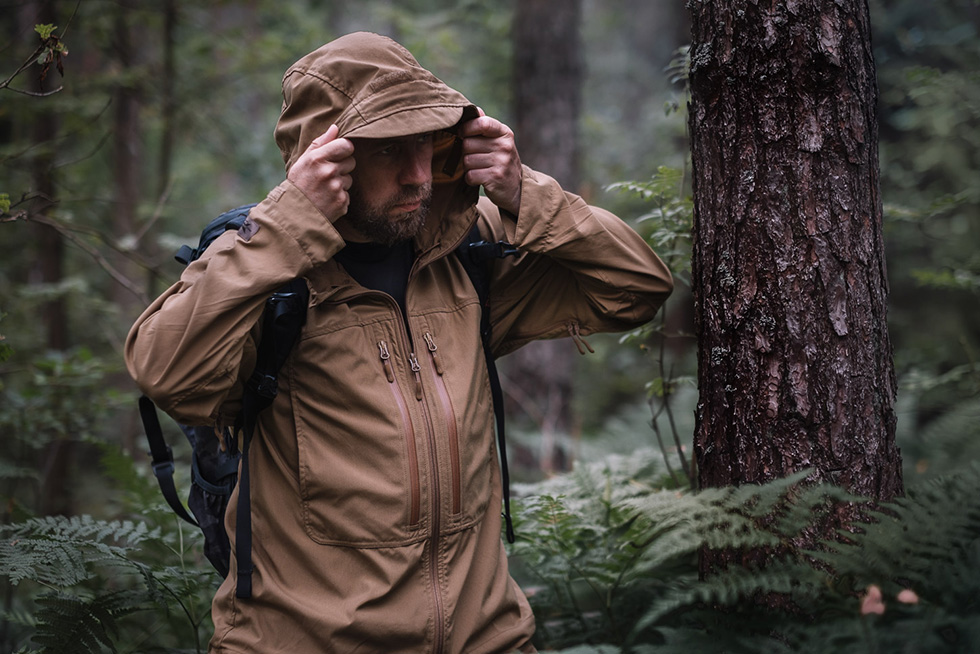
Reality
I’ve used the First Spear variant of this shell for almost five years now and it’s been with me on a multitude of trips and hikes. This is probably my most versatile shell jacket. When combined with a lightweight rain jacket and insulating layer it is enough to get me through any conditions, any season.
I carry it with me everywhere except the demanding technical mountaineering outings because the Wind Cheater comes with a slight weight penalty. I often also keep it in my SUV, just in case. Hiking, overlanding, forest exploration, general mountaineering, etc. – this jacket just works. Sure, not for the warmest sunny days. But if you’re exploring colder parts of the world in the summer, like Scandinavia, Alaska, Patagonia, or even Montana or Wyoming early summer, the Wind Cheater could be your best friend on a hike. It breathes like the best technical softshell but gives some slight insulation too in cold conditions (it can even be used as a mid-layer).
I also like how soft and silent it is; for a wildlife photographer (or a hunter) this is a critical feature. I know it may sound a bit biased, but this jacket (with a different pocket configuration, but the same concept, cut, and material) saved me more than once in the last five years and I’m still in love with this piece. If I was asked to keep just one jacket out of all the ones I have for 4-season use, the chances are it’d be the HPG Wind Cheater.
Strengths:
– extreme versatility of 4-season outdoor shell
– relaxed fit with helmet-compatible hood
– US made and tough as nails
– soft and silent
Photo credits: Piotr Ma and Mary Ma





 Carry Awards
Carry Awards Insights
Insights Liking
Liking Projects
Projects Interviews
Interviews
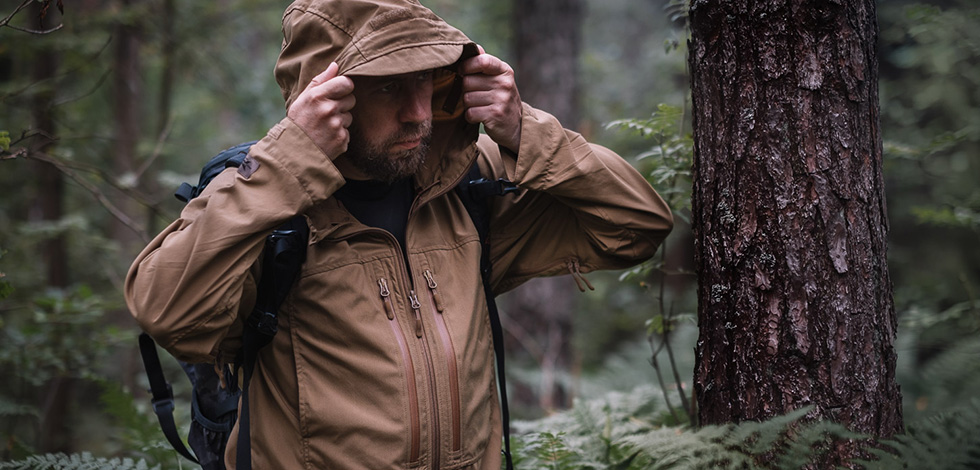




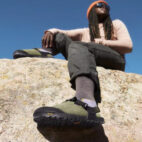
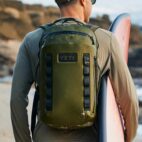
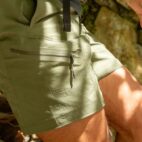
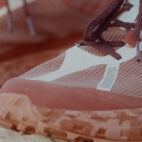




One thought on “Best Jackets for Summer Outdoor Adventures”
Comments are closed.